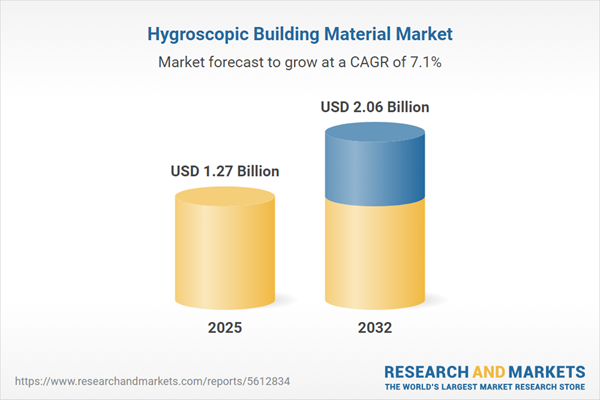Speak directly to the analyst to clarify any post sales queries you may have.
Hygroscopic building materials are increasingly recognized by senior executives as essential for modern construction, delivering tangible benefits in sustainability, compliance, and indoor environmental quality. These solutions enable efficient management of building portfolios while meeting evolving industry requirements and occupant expectations.
Market Snapshot: Hygroscopic Building Material Market Overview
The global hygroscopic building material market reached USD 1.19 billion in 2024, registering a compound annual growth rate of 7.12%. Market expansion occurs as organizations adopt advanced humidity-regulating materials to ensure healthier indoor spaces and resilient structures. New product formulations improve adaptability and durability, supporting projects in both new construction and renovations. With increased digital integration, these materials align with the shift toward smart building technologies, offering solutions for efficient energy use and compliance with contemporary building regulations. Organizations across regions are leveraging these developments to strengthen asset portfolios and operational strategies within a dynamic regulatory environment.
Scope & Segmentation: Market Coverage and Strategic Relevance
- Material Types: Cement plaster, clay plaster, composite board, gypsum board, and wood panel address structural requirements and provide flexibility. Their hygroscopic properties support demanding projects requiring precise moisture and humidity management, ensuring compatibility with current technical standards.
- Applications: Façades, cladding, rendering, roofing decks, underlayments, ceilings, interior and exterior walls, floors, and false ceilings benefit from these materials. They enhance air quality and support building resilience in diverse climates and design contexts.
- End Users: Commercial, industrial, and residential projects report improved occupant comfort, maintenance efficiency, and regulatory alignment from incorporating hygroscopic materials. The approach delivers value in both new developments and refurbishment initiatives focused on sustainability.
- Distribution Channels: Established distributor networks, digital procurement platforms, and direct online contracting provide robust sourcing options. These channels ensure continuity of supply and enable property managers and procurement leaders to manage costs and risks effectively.
- Regional Coverage: Adoption levels in the Americas, Europe, Middle East & Africa, and Asia-Pacific reflect local codes, climate variables, and market standards. Regulatory guidance from leading countries including the U.S., Germany, China, and Saudi Arabia is shaping sector adoption and influencing global best practices.
- Key Market Participants: Companies such as Compagnie de Saint-Gobain SA, Knauf Gips KG, Georgia-Pacific Gypsum LLC, Etex Group NV, National Gypsum Company, James Hardie Industries plc, USG Corporation, Armstrong World Industries, Inc., Boral Limited, and Beijing New Building Materials Co., Ltd. drive product innovation, reliability, and supply chain resilience across the value chain.
Key Takeaways for Senior Decision-Makers
- Integrating materials with humidity-regulating and moisture-management capabilities supports organizational sustainability strategies and advances environmental compliance, contributing to reduced long-term operational risks.
- Implementing sensor-enabled building components offers ongoing air quality monitoring and enables adaptive building operations that align with occupant wellbeing and strategic facilities management objectives.
- Collaboration with manufacturers and technology partners enhances supply chain robustness, providing the agility required to navigate regulatory shifts and client project demands with minimal disruption.
- Deploying versatile plaster and board systems enables project teams to manage complex design requirements and creates multipurpose spaces that accommodate future operational needs and building usages.
- Using digital procurement channels and diversified distribution methods improves transaction transparency, optimizes sourcing efficiency, and equips organizations to manage regional and global asset portfolios effectively.
Tariff Impact: U.S. Tariffs and Supply Chain Adjustment
Recent U.S. tariffs on imported gypsum and wood panel products are prompting a shift in sourcing approaches across the sector. To counteract supply chain disruptions, organizations are prioritizing domestic supplier relationships. This realignment helps maintain project schedules and reinforces development certainty in response to trade policy changes.
Methodology & Data Sources
Report findings synthesize primary research, executive-level interviews, and field surveys overseen by industry specialists. Data are validated using shipment documentation, laboratory testing, peer-reviewed studies, and up-to-date regulatory records. This multi-source methodology produces actionable insights for asset portfolio managers navigating complex operational landscapes.
Why This Report Matters
- Equips procurement and risk management teams with strategic insights into detailed market segmentation, emerging technologies, and regional trends relevant to high-value construction projects.
- Delivers practical intelligence for addressing regulatory change and construction digitalization, enabling organizations to implement resilient operational practices and informed sourcing decisions.
- Supports executive strategy development for consistent asset performance and regulatory alignment across diverse property holdings.
Conclusion
Hygroscopic building materials offer new pathways for compliance, climate adaptation, and building performance. This report provides senior leaders with the guidance needed to optimize capital strategies and enhance long-term asset value.
Additional Product Information:
- Purchase of this report includes 1 year online access with quarterly updates.
- This report can be updated on request. Please contact our Customer Experience team using the Ask a Question widget on our website.
Table of Contents
3. Executive Summary
4. Market Overview
7. Cumulative Impact of Artificial Intelligence 2025
Companies Mentioned
The companies profiled in this Hygroscopic Building Material market report include:- Compagnie de Saint-Gobain SA
- Knauf Gips KG
- Georgia-Pacific Gypsum LLC
- Etex Group NV
- National Gypsum Company
- James Hardie Industries PLC
- USG Corporation
- Armstrong World Industries, Inc.
- Boral Limited
- Beijing New Building Materials Co., Ltd
Table Information
| Report Attribute | Details |
|---|---|
| No. of Pages | 181 |
| Published | November 2025 |
| Forecast Period | 2025 - 2032 |
| Estimated Market Value ( USD | $ 1.27 Billion |
| Forecasted Market Value ( USD | $ 2.06 Billion |
| Compound Annual Growth Rate | 7.1% |
| Regions Covered | Global |
| No. of Companies Mentioned | 11 |









